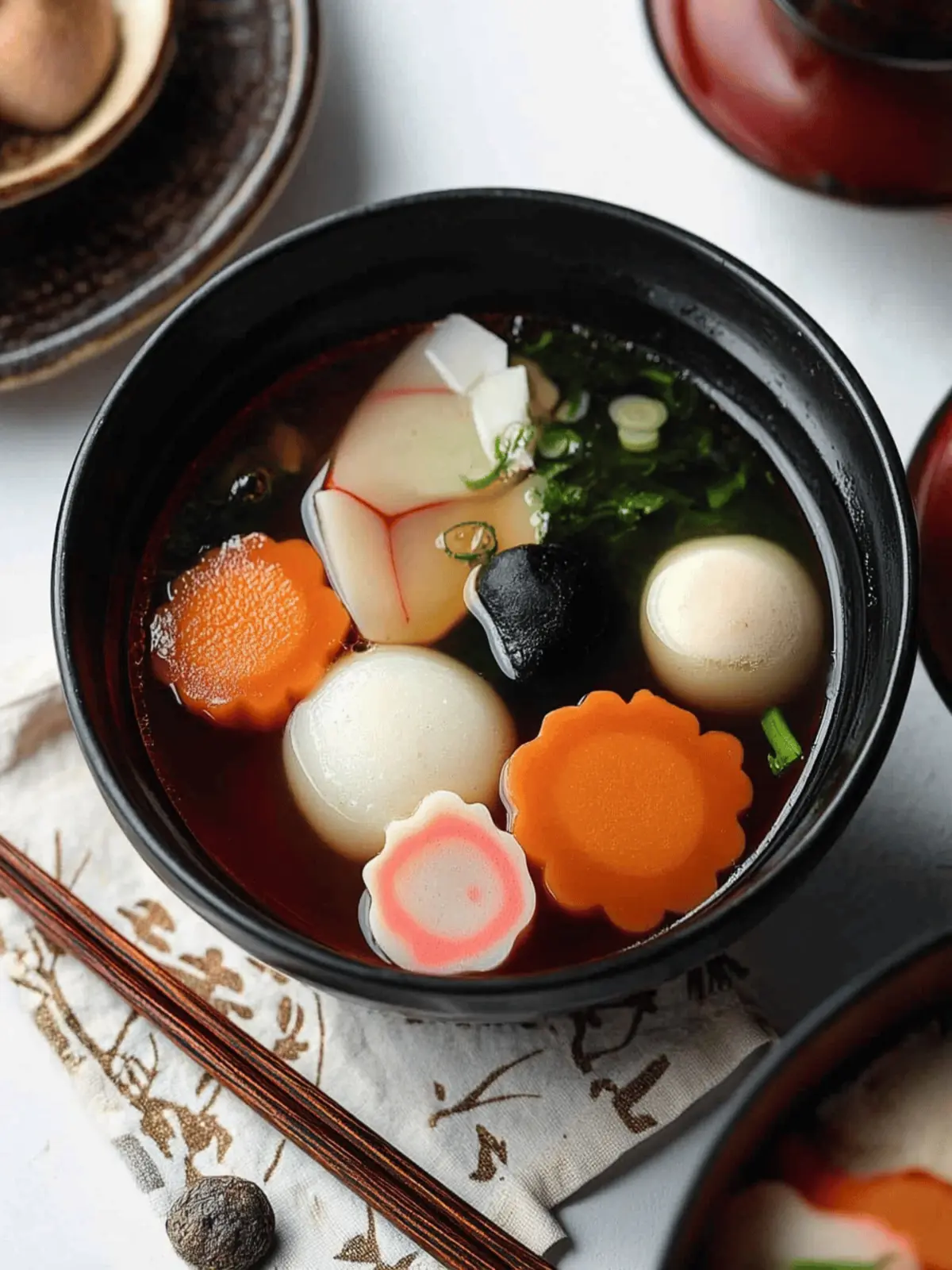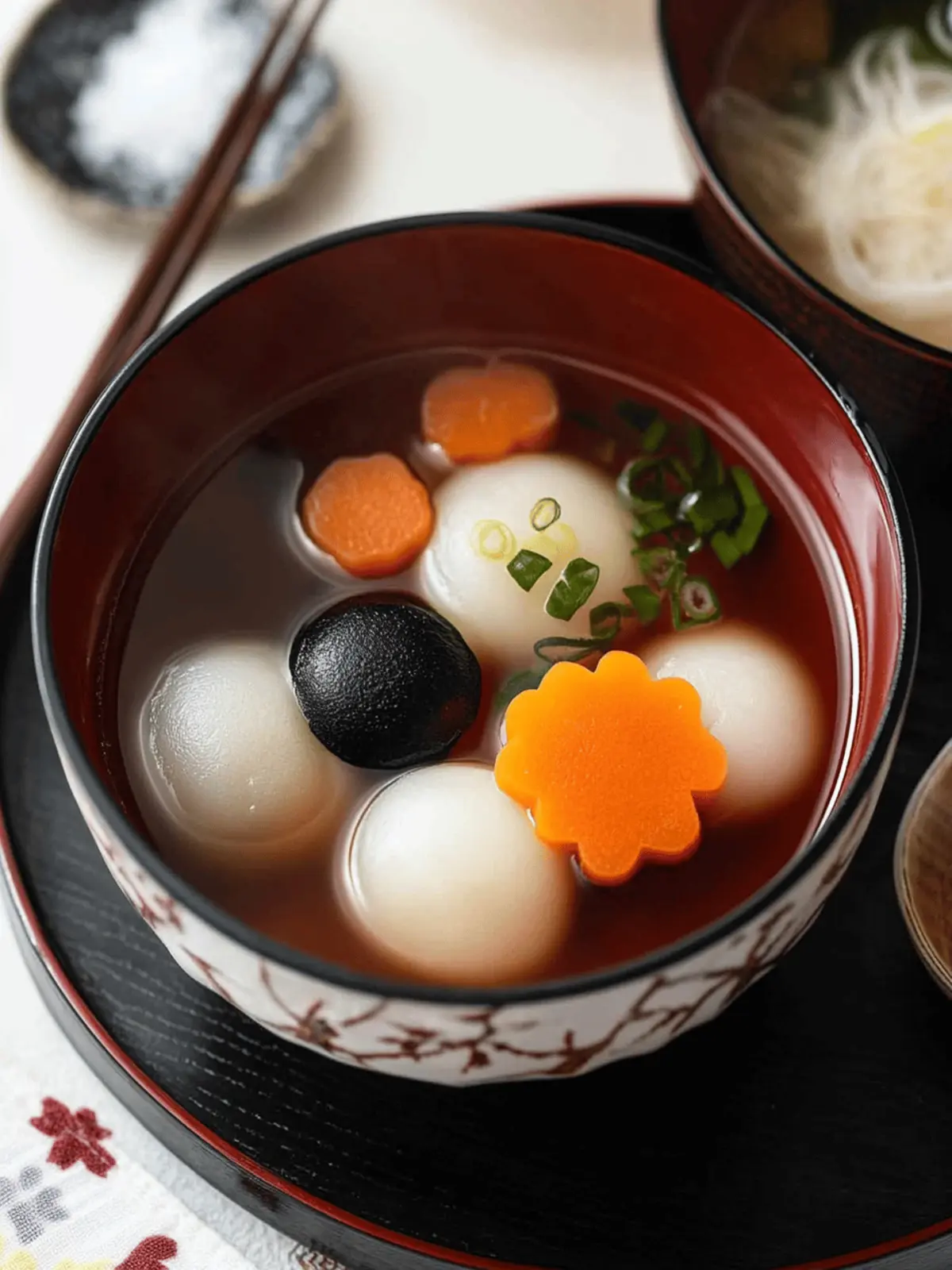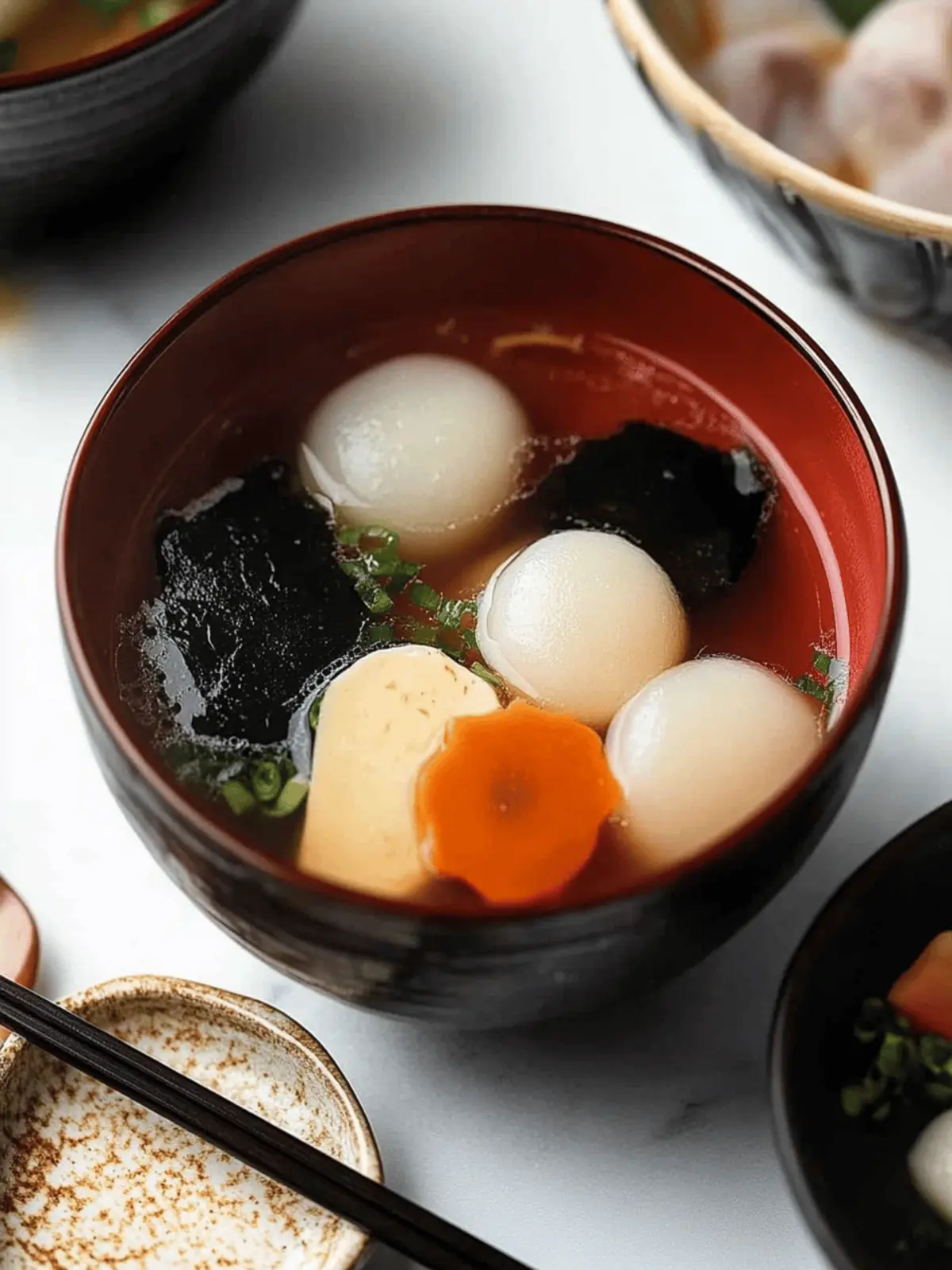As the New Year approaches, the air is filled with a sense of anticipation, and for me, that unmistakable aroma of simmering dashi and fresh vegetables brings back cherished memories of family gatherings. Ozoni, the traditional Japanese New Year Mochi Soup, is so much more than just food—it’s a warm embrace captured in a bowl, a symbol of prosperity and a time-honored ritual that warms the soul.
While we might be tempted by the allure of takeout, there’s something truly magical about creating this hearty dish at home. Each spoonful of this soothing soup, adorned with delicate mochi and vibrant vegetables, radiates love and comfort. Whether you’re gathering around with loved ones or savoring a quiet moment to yourself, this recipe invites you to celebrate the season in a deliciously thoughtful way.
So, let’s dive into the art of crafting this delightful Japanese comfort food. It’s easier than you might think, and trust me, the flavor will leave you craving more!
Why is Japanese New Year Mochi Soup special?
Delightful flavors: The rich, umami-filled dashi combined with the unique textures of mochi and fresh vegetables create a dish that’s both satisfying and heartwarming.
Cultural significance: This traditional soup is not just a meal; it embodies cultural heritage and symbolizes good fortune for the New Year.
Simplicity: With straightforward steps and easily accessible ingredients, making Ozoni is a breeze, even for novice cooks.
Versatile options: Whether you prefer the Kanto or Kansai style, you can customize this soup to suit your taste with various ingredients like shiitake mushrooms and daikon.
Perfect for gatherings: This soup is sure to impress family and friends, making it a delightful centerpiece for your New Year’s celebration or any cozy meal.
Comforting warmth: Each bowl delivers warmth and nostalgia, making it the ideal antidote to winter’s chill.
Japanese New Year Mochi Soup Ingredients
For the Soup Base
• Water – 4 cups total, essential for creating a flavorful broth.
• Kombu Dashi – 4 tsp, a rich seaweed stock that infuses umami.
• Sake – 1/2 tbsp, adds a touch of depth and flavor.
• Soy Sauce – 2 tsp, for a savory kick that enhances the dish.
• Salt – 1/4 tsp, just the right touch to balance all flavors.
For the Miso Mixture
• White Miso Paste – 2 – 2.5 tbsp, this key ingredient brings a creamy, savory note to the soup.
For the Mochi Cakes
• Shiratamako – 1/3 cup, a glutinous rice flour that makes the mochi chewy.
• Silken Tofu – 1/3 cup, provides creaminess and helps bind the dough.
For the Veggies
• Fresh Shiitake Mushrooms – 2, stems removed, they lend an earthy flavor and pleasant texture.
• Carrot – 1/2 medium, cut into shapes or slices for sweetness and color.
• Daikon – 1/4, cut into shapes or slices, adding a crunchy element to the soup.
• Soft Tofu – 1/4 block, cubed, for a delicate contrast to the mochi.
• Scallion – 1, sliced thinly, ideal for a fresh garnish.
• Spinach – optional, a handful can add vibrant color and nutrition.
• Aburaage – optional, these fried tofu pockets can add richness.
This Japanese New Year Mochi Soup recipe is a heartwarming journey into tradition, and each ingredient plays a vital role in creating a dish that’s not only delicious but also meaningful. Enjoy crafting this soothing bowl of comfort!
How to Make Japanese New Year Mochi Soup
-
Prepare the Kanto Style Soup Base: In a medium pot, combine 2 cups of water and 2 tsp of kombu dashi over medium-high heat. Stir in the sake, soy sauce, and salt until well blended.
-
Simmer the Veggies: Add the sliced carrots, daikon, and shiitake mushrooms to the pot. Bring the mixture to a boil, then reduce the heat and simmer for about 5-8 minutes, until the carrots and daikon are tender.
-
Assemble the Bowl: In a serving bowl, place 1-2 pieces of mochi along with the cooked carrots, daikon, and shiitake mushrooms. Gently pour the hot soup over the ingredients and garnish with fresh green onions.
-
Prepare the Kansai Style Soup Base: For a different twist, add 2 cups of water and 2 tsp of kombu dashi into another medium pot and warm over medium heat. Once it simmers, stir in the carrots, daikon, and shiitake mushrooms, and cook for another 5-8 minutes until tender. Remove from heat.
-
Mix in the Miso: Using a sieve, add 2-2.5 tbsp of white miso paste into the soup. Stir until the miso dissolves completely, ensuring a smooth consistency.
-
Reassemble the Bowl: Fill another bowl with the mochi, carrots, daikon, and shiitake mushrooms. Pour the miso soup over the top and finish with a sprinkle of green onions.
-
Make the Mochi Rice Cakes: In a mixing bowl, combine 1/3 cup of shiratamako and 1/3 cup of silken tofu. Use your hands to mix until a cohesive dough forms. Divide the dough into 6 equal portions and press an indentation in the center of each.
-
Cook the Mochi: Bring a pot of water to a rolling boil. Gently drop the mochi into the boiling water and cook for 4-5 minutes, or until they float to the top, indicating they are done.
-
Cool the Mochi: Using a straining ladle, carefully remove the mochi from the boiling water and plunge them into ice-cold water to stop the cooking process. Set them aside until ready to serve.
Optional: Add a handful of fresh spinach for a pop of color and nutrition.
Exact quantities are listed in the recipe card below.

What to Serve with Japanese New Year Mochi Soup?
To create a wonderfully inviting meal, pair this warm, comforting soup with a few delightful accompaniments that enhance its rich flavors and textures.
-
Steamed Rice: A bowl of fluffy steamed rice beautifully complements the soup, soaking up the flavorful broth with each bite.
-
Pickled Vegetables: Bright, tangy pickles like tsukemono provide a crisp contrast that balances the soothing warmth of the mochi soup. The crunch and acidity refresh your palate.
-
Japanese Salad: A light salad with cucumbers and daikon drizzled in sesame dressing adds freshness to your meal, enhancing the experience of this comforting dish.
-
Tempura: Light and crispy tempura vegetables or shrimp provide a delightful crunch that contrasts with the soft mochi, making each mouthful an adventure.
-
Sake or Green Tea: Enjoy a glass of warm sake or a cup of green tea to enhance the traditional experience. Both drinks perfectly complement the umami flavors of the soup.
-
Dessert: Finish off with a light dessert such as mochi ice cream for a sweet touch. Its chewy texture mirrors the main dish, creating a harmonious end to your meal.
Pairing these elements not only rounds out your dining table but also elevates the ritual of sharing this beloved Japanese New Year Mochi Soup.
Expert Tips for Japanese New Year Mochi Soup
-
Choose Quality Dashi: Use high-quality kombu dashi to enhance the umami flavor; pre-packaged dashi can sometimes lack depth.
-
Avoid Clumpy Miso: To prevent clumps in your soup, always dissolve the white miso paste in a sieve before adding it to the broth for a smooth texture.
-
Cook Mochi Carefully: Ensure that your mochi is boiled until it floats, but don’t overcook, as this can cause it to become too chewy.
-
Customize Your Veggies: Feel free to add seasonal vegetables; just remember to cut them uniformly for even cooking in this Japanese New Year Mochi Soup.
-
Serving Fresh: Ozoni is best when served immediately. Keep the broth hot until you’re ready to pour it over the ingredients for the most comforting experience.
How to Store and Freeze Japanese New Year Mochi Soup
Fridge: Store leftover soup in an airtight container for up to 3 days. Keep the mochi separate to prevent it from getting soggy.
Freezer: Freeze the soup without mochi for up to 1 month. Pour into freezer-safe containers, leaving some space for expansion.
Reheating: Thaw overnight in the fridge and reheat on the stovetop until hot. Add freshly made mochi for best texture.
Avoid Freezing: Do not freeze mochi after it’s cooked, as it can change texture; prepare fresh mochi when serving the thawed soup.
Make Ahead Options
Japanese New Year Mochi Soup is ideal for busy home cooks looking to save time without sacrificing flavor! You can prepare the soup base (without miso) and the cooked vegetables up to 3 days in advance. Simply refrigerate the soup base in an airtight container until you’re ready to enjoy. On the day of serving, reheat the soup and stir in the miso until fully dissolved. Meanwhile, you can make the mochi rice cakes and store them in the fridge for up to 24 hours. When you’re ready to eat, quickly boil the mochi for a couple of minutes and assemble your bowls with the reheated soup and vegetables. This way, your Japanese New Year Mochi Soup will taste just as delicious, all while maximizing your meal prep efficiency!
Japanese New Year Mochi Soup Variations
Feel free to add your personal touch to this warm, comforting soup for a delightful twist on tradition.
-
Vegan: Use vegetable broth instead of dashi and swap silken tofu for firm tofu for a heartier texture. This will still keep it rich and flavorful!
-
Spicy Kick: Add a dash of chili oil or sprinkle some red pepper flakes in your bowl before serving. The heat beautifully complements the umami flavors.
-
Herb Infusion: Incorporate fresh herbs like cilantro or shiso to the garnishing layer. These can provide an aromatic freshness that lifts every scoop.
-
Different Mushrooms: Replace shiitake with oyster mushrooms or enoki for varied textures and earthy flavors. Each type can bring a unique twist to every bowl.
-
Add More Greens: Toss in some bok choy or kale for a pop of color and nutrition. The brightness of these greens will elevate the presentation!
-
Rice Cakes Variety: Use commercially available sweet mochi for a hint of sweetness, perfectly contrasting with the savory soup base.
-
Nutty Flavor: Drizzle a bit of sesame oil over the finished soup for a warm, nutty aroma that enhances the dish’s depth.
-
Crispy Toppers: Think about adding fried garlic or shallots as a garnish. They provide a wonderful crunch that perfectly complements the soft vegetables and mochi!

Japanese New Year Mochi Soup Recipe FAQs
What type of dashi should I use for Japanese New Year Mochi Soup?
Absolutely! For the best flavor, I recommend using high-quality kombu dashi. This seaweed-based broth is rich in umami and essential for creating a flavorful base for your Ozoni. If you’re pressed for time, a pre-packaged dashi can be convenient, but the taste may not be as deep.
How should I store leftover Japanese New Year Mochi Soup?
You can store leftover soup in an airtight container in the fridge for up to 3 days. Just make sure to keep the mochi separate to prevent it from becoming soggy. When you’re ready to enjoy it again, simply heat the soup on the stove until hot and add fresh mochi if you can!
Can I freeze Japanese New Year Mochi Soup?
Certainly! Without the mochi, you can freeze the soup for up to 1 month. Pour it into freezer-safe containers, but leave some space for expansion as it freezes. To reheat, thaw in the fridge overnight and warm it on the stove until piping hot. I often make fresh mochi while the soup heats for a delightful experience!
How can I avoid clumpy miso in my soup?
Very easy! To prevent clumps of miso in your soup, always use a sieve when adding the white miso paste. Measure out the miso into the sieve and stir it in gently until dissolved; this ensures a beautifully smooth broth without any lumps.
What vegetables can I use in Japanese New Year Mochi Soup?
You can customize your soup with seasonal vegetables! Carrots, daikon, and shiitake mushrooms are traditional, but feel free to experiment. Just remember to cut them into uniform sizes for even cooking. Spinach adds a lovely color and can enhance the nutritional value too, so the more the merrier!
Can I make this recipe vegan?
Definitely! To make the Japanese New Year Mochi Soup vegan, simply replace the sake with a little extra water and omit any non-vegan ingredients like soft tofu. Use vegetable broth instead of dashi for a plant-based version while keeping all the delightful flavors intact!

Japanese New Year Mochi Soup: Warmth in Every Bowl
Ingredients
Equipment
Method
- In a medium pot, combine 2 cups of water and 2 tsp of kombu dashi over medium-high heat. Stir in the sake, soy sauce, and salt until well blended.
- Add the sliced carrots, daikon, and shiitake mushrooms to the pot. Bring to a boil, then reduce heat and simmer for 5-8 minutes until tender.
- In a serving bowl, place 1-2 pieces of mochi along with the cooked veggies. Gently pour the hot soup over the ingredients and garnish with scallions.
- For a twist, in another pot, add 2 cups of water and 2 tsp of kombu dashi and warm over medium heat. Stir in the carrots, daikon, and shiitake mushrooms, cooking for 5-8 minutes until tender. Remove from heat.
- Using a sieve, add 2-2.5 tbsp of white miso paste into the soup. Stir until the miso dissolves completely for a smooth consistency.
- Fill another bowl with the mochi, carrots, daikon, and shiitake mushrooms. Pour the miso soup over the top and finish with green onions.
- In a mixing bowl, combine 1/3 cup of shiratamako and 1/3 cup of silken tofu, mixing until a cohesive dough forms. Divide into 6 portions and make indentations in each.
- Bring a pot of water to a rolling boil. Drop the mochi into the water and cook for 4-5 minutes or until they float to the top.
- Using a straining ladle, remove the mochi and plunge them into ice-cold water to stop cooking. Set aside until ready to serve.






